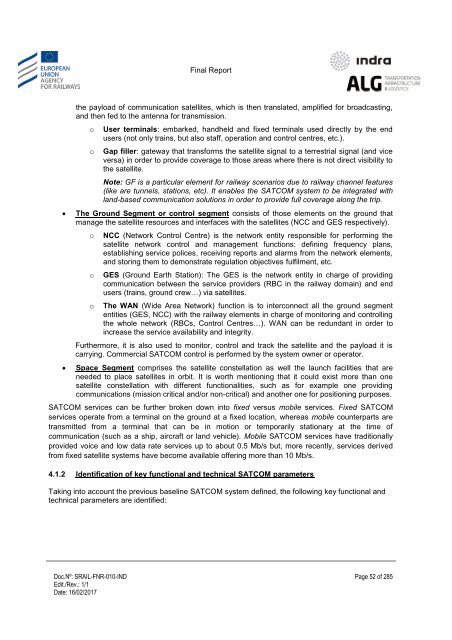Study on feasibility of SATCOM for railway communication
SRAIL-FNR-010-IND%20-%20FinalReport_v1.1_20170216
SRAIL-FNR-010-IND%20-%20FinalReport_v1.1_20170216
Create successful ePaper yourself
Turn your PDF publications into a flip-book with our unique Google optimized e-Paper software.
Final Report<br />
<br />
<br />
the payload <strong>of</strong> communicati<strong>on</strong> satellites, which is then translated, amplified <strong>for</strong> broadcasting,<br />
and then fed to the antenna <strong>for</strong> transmissi<strong>on</strong>.<br />
o<br />
o<br />
User terminals: embarked, handheld and fixed terminals used directly by the end<br />
users (not <strong>on</strong>ly trains, but also staff, operati<strong>on</strong> and c<strong>on</strong>trol centres, etc.).<br />
Gap filler: gateway that trans<strong>for</strong>ms the satellite signal to a terrestrial signal (and vice<br />
versa) in order to provide coverage to those areas where there is not direct visibility to<br />
the satellite.<br />
Note: GF is a particular element <strong>for</strong> <strong>railway</strong> scenarios due to <strong>railway</strong> channel features<br />
(like are tunnels, stati<strong>on</strong>s, etc). It enables the <strong>SATCOM</strong> system to be integrated with<br />
land-based communicati<strong>on</strong> soluti<strong>on</strong>s in order to provide full coverage al<strong>on</strong>g the trip.<br />
The Ground Segment or c<strong>on</strong>trol segment c<strong>on</strong>sists <strong>of</strong> those elements <strong>on</strong> the ground that<br />
manage the satellite resources and interfaces with the satellites (NCC and GES respectively).<br />
o<br />
o<br />
o<br />
NCC (Network C<strong>on</strong>trol Centre) is the network entity resp<strong>on</strong>sible <strong>for</strong> per<strong>for</strong>ming the<br />
satellite network c<strong>on</strong>trol and management functi<strong>on</strong>s: defining frequency plans,<br />
establishing service polices, receiving reports and alarms from the network elements,<br />
and storing them to dem<strong>on</strong>strate regulati<strong>on</strong> objectives fulfilment, etc.<br />
GES (Ground Earth Stati<strong>on</strong>): The GES is the network entity in charge <strong>of</strong> providing<br />
communicati<strong>on</strong> between the service providers (RBC in the <strong>railway</strong> domain) and end<br />
users (trains, ground crew…) via satellites.<br />
The WAN (Wide Area Network) functi<strong>on</strong> is to interc<strong>on</strong>nect all the ground segment<br />
entities (GES, NCC) with the <strong>railway</strong> elements in charge <strong>of</strong> m<strong>on</strong>itoring and c<strong>on</strong>trolling<br />
the whole network (RBCs, C<strong>on</strong>trol Centres…). WAN can be redundant in order to<br />
increase the service availability and integrity.<br />
Furthermore, it is also used to m<strong>on</strong>itor, c<strong>on</strong>trol and track the satellite and the payload it is<br />
carrying. Commercial <strong>SATCOM</strong> c<strong>on</strong>trol is per<strong>for</strong>med by the system owner or operator.<br />
Space Segment comprises the satellite c<strong>on</strong>stellati<strong>on</strong> as well the launch facilities that are<br />
needed to place satellites in orbit. It is worth menti<strong>on</strong>ing that it could exist more than <strong>on</strong>e<br />
satellite c<strong>on</strong>stellati<strong>on</strong> with different functi<strong>on</strong>alities, such as <strong>for</strong> example <strong>on</strong>e providing<br />
communicati<strong>on</strong>s (missi<strong>on</strong> critical and/or n<strong>on</strong>-critical) and another <strong>on</strong>e <strong>for</strong> positi<strong>on</strong>ing purposes.<br />
<strong>SATCOM</strong> services can be further broken down into fixed versus mobile services. Fixed <strong>SATCOM</strong><br />
services operate from a terminal <strong>on</strong> the ground at a fixed locati<strong>on</strong>, whereas mobile counterparts are<br />
transmitted from a terminal that can be in moti<strong>on</strong> or temporarily stati<strong>on</strong>ary at the time <strong>of</strong><br />
communicati<strong>on</strong> (such as a ship, aircraft or land vehicle). Mobile <strong>SATCOM</strong> services have traditi<strong>on</strong>ally<br />
provided voice and low data rate services up to about 0.5 Mb/s but, more recently, services derived<br />
from fixed satellite systems have become available <strong>of</strong>fering more than 10 Mb/s.<br />
4.1.2 Identificati<strong>on</strong> <strong>of</strong> key functi<strong>on</strong>al and technical <strong>SATCOM</strong> parameters<br />
Taking into account the previous baseline <strong>SATCOM</strong> system defined, the following key functi<strong>on</strong>al and<br />
technical parameters are identified:<br />
Doc.Nº: SRAIL-FNR-010-IND<br />
Edit./Rev.: 1/1<br />
Date: 16/02/2017<br />
Page 52 <strong>of</strong> 285


